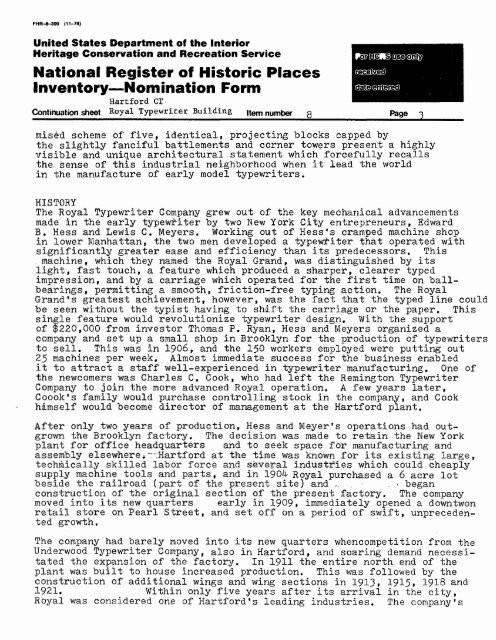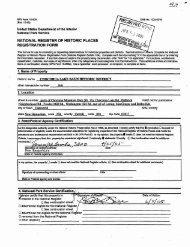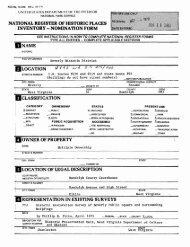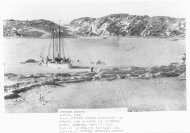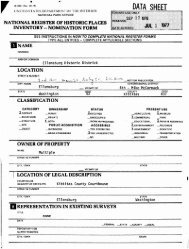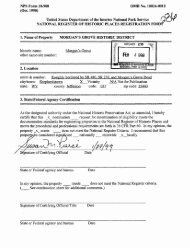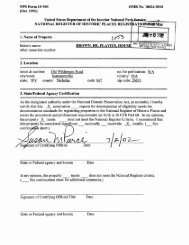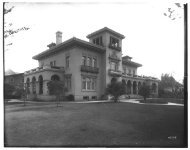National Register of Historic Places Inventory Nomination Form
National Register of Historic Places Inventory Nomination Form
National Register of Historic Places Inventory Nomination Form
You also want an ePaper? Increase the reach of your titles
YUMPU automatically turns print PDFs into web optimized ePapers that Google loves.
FHR-8-300 (11-78)<br />
United States Department <strong>of</strong> the Interior<br />
Heritage Conservation and Recreation Service<br />
<strong>National</strong> <strong>Register</strong> <strong>of</strong> <strong>Historic</strong> <strong>Places</strong><br />
<strong>Inventory</strong> <strong>Nomination</strong> <strong>Form</strong><br />
Hartford CT<br />
Continuation sheet Royal Typewriter Building item number Q___________Page 3______<br />
mised scheme <strong>of</strong> five, identical, projecting blocks capped by<br />
the slightly fanciful battlements and corner towers present a highly<br />
visible and unique architectural statement which forcefully recalls<br />
the sense <strong>of</strong> this industrial neighborhood when it lead the .world<br />
in the manufacture <strong>of</strong> early model typewriters.<br />
HISTORY<br />
The Royal Typewriter Company grew out <strong>of</strong> the key mechanical advancements<br />
made in the early typewriter by two New York City entrepreneurs, Edward<br />
B. Hess and Lewis C, Meyers. Working out <strong>of</strong> Hess's cramped machine shop<br />
in lower Manhattan, the two men developed a typewriter that operated with<br />
significantly greater ease and efficiency than its predecessors. This<br />
machine, which they named the Royal Grand, was distinguished by its<br />
light, fast touch, a feature which produced a sharper, clearer typed<br />
impression, and by a carriage which operated for the first time on ball<br />
bearings, permitting a smooth, friction-free typing action. The Royal<br />
Grand's greatest achievement, however, was the fact that the typed line could<br />
be seen without the typist having to shift the carriage or the paper. This<br />
single feature would revolutionize typewriter design. With the support<br />
<strong>of</strong> $220,000 from investor Thomas P. Ryan, Hess and Meyers organized a<br />
company and set up a small shop in Brooklyn for the production <strong>of</strong> typewriters<br />
to sell. This was in 1906, and the 150 workers employed were putting out<br />
25 machines per week. Almost immediate success for the business enabled<br />
it to attract a staff well-experienced in typewriter manufacturing. One <strong>of</strong><br />
the newcomers was Charles C, Cook, who had left the Remington Typewriter<br />
Company to join the more advanced Royal operation, A few years later,<br />
Coook's family would purchase controlling stock in the company, and Cook<br />
himself would become director <strong>of</strong> management at the Hartford plant.<br />
After only two years <strong>of</strong> production, Hess and Meyer's operations had out<br />
grown the Brooklyn factory. The decision was made to retain the New York<br />
plant for <strong>of</strong>fice headquarters and to seek space for manufacturing and<br />
assembly elsewhere*/:-:Hartford at the time was known for its existing large,<br />
technically skilled labor force and several industries which could cheaply<br />
supply machine tools and parts, and in 1904 Royal purchased a 6 acre lot<br />
beside the railroad (part <strong>of</strong> the present site) and ,. , • . < began<br />
construction <strong>of</strong> the original section <strong>of</strong> the present factory. The company<br />
moved into its new quarters early in 1909, immediately opened a downtwon<br />
retail store on Pearl Street, and set <strong>of</strong>f on a period <strong>of</strong> swift, unpreceden<br />
ted growth.<br />
The company had barely moved into its new quarters whencompetition from the<br />
Underwood Typewriter Company, also in Hartford, and soaring demand necessi<br />
tated the expansion <strong>of</strong> the factory. In 1911 the entire north end <strong>of</strong> the<br />
plant was built to house increased production. This was followed by the<br />
construction <strong>of</strong> additional wings and wing sections in 1913, 1915, 1918 and<br />
1921. Within only five years after its arrival in the city,<br />
Royal was considered one <strong>of</strong> Hartford's leading industries. The company's


